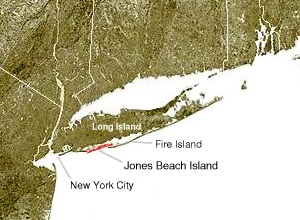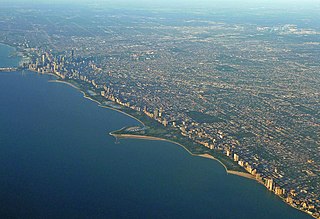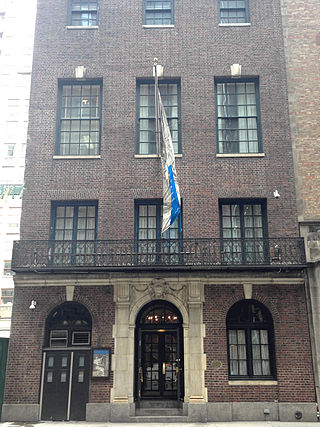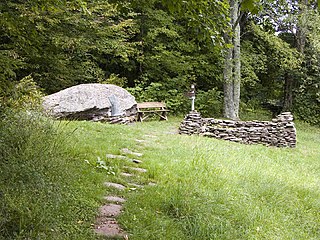
A nature reserve is a protected area of importance for flora, fauna, or features of geological or other special interest, which is reserved and managed for purposes of conservation and to provide special opportunities for study or research. They may be designated by government institutions in some countries, or by private landowners, such as charities and research institutions. Nature reserves fall into different IUCN categories depending on the level of protection afforded by local laws. Normally it is more strictly protected than a nature park. Various jurisdictions may use other terminology, such as ecological protection area or private protected area in legislation and in official titles of the reserves.

Floral Park is an incorporated village in Nassau County, New York, United States, on Long Island. The population as of the US Census of 2010 is 15,863.

The fishing cat is a medium-sized wild cat of South and Southeast Asia. Since 2016, it is listed as Vulnerable on the IUCN Red List. Fishing cat populations are threatened by destruction of wetlands and have declined severely over the last decade. The fishing cat lives foremost in the vicinity of wetlands, along rivers, streams, oxbow lakes, in swamps, and mangroves.

Jones Beach Island is one of the outer barrier islands off the southern coast of Long Island in the U.S. state of New York.

Pelham Bay Park is a municipal park located in the northeast corner of the New York City borough of the Bronx. It is, at 2,772 acres (1,122 ha), the largest public park in New York City. The park is more than three times the size of Manhattan's Central Park. The park is operated by the New York City Department of Parks and Recreation.

Lincoln Park is a 1,208-acre (489-hectare) park along Lake Michigan on the North Side of Chicago, Illinois. Named after US President Abraham Lincoln, it is the city's largest public park and stretches for seven miles (11 km) from Grand Avenue, on the south, to near Ardmore Avenue on the north, just north of the DuSable Lake Shore Drive terminus at Hollywood Avenue. Two museums and a zoo are located in the oldest part of the park between North Avenue and Diversey Parkway in the eponymous neighborhood. Further to the north, the park is characterized by parkland, beaches, recreational areas, nature reserves, and harbors. To the south, there is a more narrow strip of beaches east of Lake Shore Drive, almost to downtown. With 20 million visitors per year, Lincoln Park is the second-most-visited city park in the United States, behind Central Park.

John Burroughs was an American naturalist and nature essayist, active in the conservation movement in the United States. The first of his essay collections was Wake-Robin in 1871.

David Quammen is an American science, nature, and travel writer and the author of fifteen books. His articles have appeared in Outside Magazine, National Geographic, Harper's, Rolling Stone, The New York Times Book Review, The New Yorker, and other periodicals.
The LeTort Spring Run is a 9.4-mile-long (15.1 km) tributary of Conodoguinet Creek in Cumberland County, Pennsylvania in the United States.

The Grolier Club is a private club and society of bibliophiles in New York City. Founded in January 1884, it is the oldest existing bibliophilic club in North America. The club is named after Jean Grolier de Servières, Viscount d'Aguisy, Treasurer General of France, whose library was famous; his motto, "Io. Grolierii et amicorum" [of or belonging to Jean Grolier and his friends], suggested his generosity in sharing books. The Club's stated objective is "the literary study of the arts pertaining to the production of books, including the occasional publication of books designed to illustrate, promote and encourage these arts; and the acquisition, furnishing and maintenance of a suitable club building for the safekeeping of its property, wherein meetings, lectures and exhibitions shall take place from time to time ..."

Slabsides is the log cabin built by naturalist John Burroughs and his son on a nine-acre wooded and hilly tract in 1895 one mile (1.6 km) west of Riverby, his home in West Park, New York. From the time of its construction to the last year of his life, Burroughs received many visitors at the cabin, ranging from Theodore Roosevelt and Henry Ford to students from Vassar College, just across the Hudson River.

Riverby was the estate of the American naturalist John Burroughs (1837–1921), who wrote and created a genre of naturalist essays. It is located above the west bank of the Hudson River, in the town of West Park, in Ulster County, New York. Burroughs built the main house and a separate study, where he did much of his most influential writing. The property was designated a National Historic Landmark in 1968. It is private property, still partially held by the Burroughs family, and is not open to the public.

Woodchuck Lodge is a historic house on Burroughs Memorial Road in a remote part of the western Catskills in Roxbury, New York. Built in the mid-19th century, it was the last home of naturalist and writer John Burroughs (1837-1921) from 1908, and is the place of his burial. The property is now managed by the state of New York as the John Burroughs Memorial State Historic Site, and the house is open for tours on weekends between May and October. The property is a National Historic Landmark, designated in 1962 for its association with Burroughs, one of the most important nature writers of the late 19th and early 20th centuries.

The Audubon Society of Portland is a non-profit environmental organization dedicated to wildlife conservancy in Portland, Oregon, United States.
Protected areas of Indonesia comprise both terrestrial and marine environments in any of the six IUCN Protected Area categories. There are over 500 protected areas in Indonesia, of which 54 National Parks cover 16.4 million ha, and another 527 nature and game reserves cover a further 28.3 million ha. The total protected land area represents over 15% of Indonesia's landmass. Marine Protected Areas comprise over 15.7 million ha representing ca. 5% of territorial waters.

The Pequonnock River is a 16.7-mile-long (26.9 km) waterway in eastern Fairfield County, Connecticut. Its watershed is located in five communities, with the majority of it located within Monroe, Trumbull, and Bridgeport. The river has a penchant for flooding, particularly in spring since the removal of a retention dam in Trumbull in the 1950s. There seems to be a sharp difference of opinion among historians as to just what the Indian word Pequonnock signifies. Some insist it meant cleared field or open ground; others are sure it meant broken ground; while a third group is certain it meant place of slaughter or place of destruction.

The Marlboro Mountains, sometimes Marlborough Mountains, are a group of hogbacked mountains arranged in a 25-mile-long (40 km) ridge extending from Newburgh, New York, to just south of Kingston, New York. Considered to be part of the Ridge and Valley Appalachians, the mountains, which reach elevations over 1,100 feet, form an imposing geologic barrier just west of the Hudson River. They subdivide the relatively flat Hudson River Valley to create the Wallkill Valley further west. Rising abruptly on their eastern flanks, the Marlboro Mountains are known for their sweeping views of the region.

Shaupeneak Ridge Cooperative Recreation Area is a 790-acre (320 ha) recreational and protected area in the U.S. state of New York. It is located in the town of Esopus in eastern Ulster County. Shaupeneak Ridge Cooperative Recreation Area (CRA) covers part of the ridge-top, slope, and base of Shaupeneak Mountain, an 892-foot (272 m) high ridge of the Marlboro Mountains, which stretch from Newburgh, New York to Kingston, New York.
















